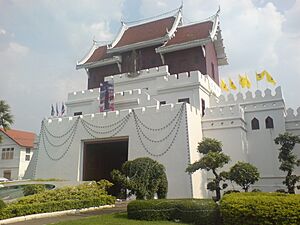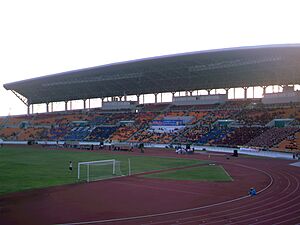Nakhon Ratchasima facts for kids
Quick facts for kids
Nakhon Ratchasima
นครราชสีมา
Korat
|
||
|---|---|---|
|
City municipality
|
||
|
From top left: View of Nakhon Ratchasima, monument of Thao Suranari with the Chumphon Gate in the background, Nakhon Ratchasima railway station, 80th Birthday Stadium and Central Korat
|
||
|
||
| Country | ||
| Province | Nakhon Ratchasima | |
| District | Mueang Nakhon Ratchasima | |
| Settled | 1656 (Ayutthaya Period) | |
| Sanitation | 3 Jan 1908 | |
| Town | 10 Dec 1935 | |
| City | 24 Sept 1995 | |
| Government | ||
| • Type | City municipality | |
| Area | ||
| • City municipality | 37.5 km2 (14.5 sq mi) | |
| • Urban | 755.6 km2 (291.73 sq mi) | |
| Area rank | 13th | |
| Elevation | 180 m (590 ft) | |
| Population
(2019)
|
||
| • City municipality | 126,391 (Registered residents) |
|
| • Rank | 3rd (Urban) | |
| • Density | 3,370/km2 (8,700/sq mi) | |
| • Urban | 466,098 | |
| • Urban density | 616.85/km2 (1,597.6/sq mi) | |
| Time zone | UTC+7 (ICT) | |
| Postcode |
30000
|
|
| Calling code | 044 | |
Nakhon Ratchasima (Thai: นครราชสีมา) is a big city in Thailand. It is the capital of Nakhon Ratchasima province. People often call it Korat (โคราช) for short.
Korat is the largest city in Isan, which is Northeastern Thailand. It's also the third-largest city in all of Thailand. The city is about 250 kilometers (155 miles) northeast of Bangkok. It sits at the western edge of the Korat Plateau. Long ago, Korat was a border between the lands of Laos and Thailand. It is known as the "gateway" to the Lao-speaking parts of Northeast Thailand.
Contents
- What's in a Name? The Meaning of Korat
- A Look Back: The History of Korat
- Who Lives in Korat? The City's Population
- How Korat is Governed
- Weather in Korat: A Tropical Climate
- Korat's Economy: How the City Makes Money
- Getting Around: Transport in Korat
- Learning in Korat: Schools and Universities
- Staying Healthy: Hospitals in Korat
- Sports in Korat: Home of Champions
- Images for kids
- See also
What's in a Name? The Meaning of Korat
The name Nakhon Ratchasima has a cool history! Long ago, there were two old towns nearby. One was called Sema and the other Khorakapura.
The name Nakhon Raj comes from Nakhon meaning "city" and Raj meaning "sovereign" or "ruler". The full name, Nakhon Ratchasima, is a mix of Nakhon Raj and Sema. The shorter name "Korat" comes from an old Khmer name, "ankor raj."
A Look Back: The History of Korat
Before the 14th century, the area of Nakhon Ratchasima was part of the Khmer empire. It was known by names like Angkor raj or Koreach. Another town called Phimai, to the north, was probably more important back then.
Building a Stronghold: King Narai's Vision
In the 17th century, King Narai of the Ayutthaya Kingdom decided to build a new city here. He wanted it to be a strong fort to protect Ayutthaya's northeastern border. From then on, Nakhon Ratchasima was an important "second-class" city in the Ayutthaya Kingdom. A royal governor, whose position was passed down in his family, ruled the city.
After Ayutthaya: A New Kingdom and Heroic Deeds
The Ayutthaya Kingdom was completely destroyed by the Burmese in 1767. After this, a son of King Boromakot tried to become ruler in Phimai, controlling Korat and other eastern areas. King Taksin of the Thonburi Kingdom sent two generals to stop him. Korat then became a key place for King Rama I to watch over the Lao and Khmer lands.
In 1826, King Anouvong of Vientiane attacked Korat. He thought Siam was weak. This led to the Laotian Rebellion. Lady Mo, the wife of the deputy governor, is famous for helping free the city from Anouvong's army. There's a statue of her in downtown Korat to honor her bravery.
Modern Times: Railways and Growth
Nakhon Ratchasima continued to be a major center for politics and business in the northeast. In 1900, the Royal State Railways of Siam started train services from Bangkok to Korat. King Chulalongkorn officially opened it. More railway lines were added later, connecting Korat to other important cities.
During World War II, soldiers from Nakhon Ratchasima fought in the Franco-Thai War. After the war, the United States helped build Mittraphap Road, a major road connecting Saraburi to Nakhon Ratchasima.
Recent Events in Korat
In 1993, a sad event happened when the Royal Plaza Hotel collapsed, causing many deaths. In February 2020, the city experienced a tragic shooting incident at a local mall. These events were very difficult for the community.
Who Lives in Korat? The City's Population
As of 2019, Nakhon Ratchasima Municipality had about 126,391 people living there. But the city has grown a lot! The larger urban area of Korat, which includes nearby areas, had a population of 466,098 people in 2021. This makes Korat the third-largest city in Thailand by urban population, after Bangkok and Chiang Mai.
How Korat is Governed
Korat started as a sanitation district in 1908. It became a town municipality in 1935 and was later expanded in size. In 1995, its status was upgraded to a city municipality (thesaban nakhon). The city municipality manages services for its residents.
Weather in Korat: A Tropical Climate
Nakhon Ratchasima has a tropical savanna climate. This means it's generally warm all year. Most of its rain falls between May and October.
| Climate data for Nakhon Ratchasima (1991–2020) | |||||||||||||
|---|---|---|---|---|---|---|---|---|---|---|---|---|---|
| Month | Jan | Feb | Mar | Apr | May | Jun | Jul | Aug | Sep | Oct | Nov | Dec | Year |
| Record high °C (°F) | 37.7 (99.9) |
40.6 (105.1) |
42.3 (108.1) |
44.0 (111.2) |
42.7 (108.9) |
39.2 (102.6) |
39.2 (102.6) |
37.2 (99.0) |
36.7 (98.1) |
35.1 (95.2) |
36.1 (97.0) |
36.0 (96.8) |
44.0 (111.2) |
| Mean daily maximum °C (°F) | 31.0 (87.8) |
33.5 (92.3) |
35.7 (96.3) |
36.6 (97.9) |
35.4 (95.7) |
34.7 (94.5) |
34.0 (93.2) |
33.3 (91.9) |
32.4 (90.3) |
31.3 (88.3) |
30.9 (87.6) |
29.9 (85.8) |
33.2 (91.8) |
| Daily mean °C (°F) | 24.8 (76.6) |
26.9 (80.4) |
29.2 (84.6) |
30.1 (86.2) |
29.5 (85.1) |
29.3 (84.7) |
28.8 (83.8) |
28.3 (82.9) |
27.6 (81.7) |
27.0 (80.6) |
26.0 (78.8) |
24.4 (75.9) |
27.7 (81.8) |
| Mean daily minimum °C (°F) | 19.2 (66.6) |
21.1 (70.0) |
23.7 (74.7) |
25.1 (77.2) |
25.4 (77.7) |
25.4 (77.7) |
25.0 (77.0) |
24.8 (76.6) |
24.4 (75.9) |
23.6 (74.5) |
21.5 (70.7) |
19.3 (66.7) |
23.2 (73.8) |
| Record low °C (°F) | 4.9 (40.8) |
10.6 (51.1) |
13.0 (55.4) |
16.0 (60.8) |
18.9 (66.0) |
22.0 (71.6) |
21.3 (70.3) |
21.7 (71.1) |
20.4 (68.7) |
16.6 (61.9) |
9.1 (48.4) |
6.2 (43.2) |
4.9 (40.8) |
| Average precipitation mm (inches) | 8.6 (0.34) |
12.7 (0.50) |
46.3 (1.82) |
79.5 (3.13) |
151.7 (5.97) |
120.0 (4.72) |
130.1 (5.12) |
178.0 (7.01) |
238.8 (9.40) |
135.0 (5.31) |
19.6 (0.77) |
2.6 (0.10) |
1,122.9 (44.21) |
| Average precipitation days (≥ 1.0 mm) | 1.0 | 1.3 | 3.7 | 5.7 | 10.5 | 9.2 | 10.1 | 12.5 | 14.4 | 8.9 | 2.0 | 0.5 | 79.8 |
| Average relative humidity (%) | 65.7 | 62.1 | 62.6 | 66.4 | 73.4 | 73.0 | 74.0 | 76.6 | 81.2 | 78.4 | 71.2 | 66.4 | 70.9 |
| Mean monthly sunshine hours | 226.3 | 211.9 | 201.5 | 186.0 | 155.0 | 114.0 | 117.8 | 117.8 | 108.0 | 145.7 | 186.0 | 226.3 | 1,996.3 |
| Mean daily sunshine hours | 7.3 | 7.5 | 6.5 | 6.2 | 5.0 | 3.8 | 3.8 | 3.8 | 3.6 | 4.7 | 6.2 | 7.3 | 5.5 |
| Source 1: World Meteorological Organization | |||||||||||||
| Source 2: Office of Water Management and Hydrology, Royal Irrigation Department (sun 1981–2010)(extremes) | |||||||||||||
Korat's Economy: How the City Makes Money
Korat's economy has always relied a lot on farming. It's a big center for processing rice, tapioca, and sugar from the Isan region. These three farm products support 700,000 families in Isan. Korat is also home to a factory that makes disk drives for computers, employing many people.
Shopping Fun: Retail in Korat
Korat has become a major shopping spot. Not just for Isan, but also for nearby Cambodia and Laos. Many big department stores from Bangkok have opened large malls here. This means lots of places to shop and explore!
Getting Around: Transport in Korat
By Air: Nakhon Ratchasima Airport
Nakhon Ratchasima Airport is about 26 kilometers (16 miles) east of the city. Currently, there are no regular flights from this airport.
By Train: Railway Connections
Nakhon Ratchasima is on the northeastern railway line. This line connects Bangkok to cities like Ubon Ratchathani and Nong Khai. There are two main train stations in the city: Nakhon Ratchasima Railway Station and Thanon Chira Junction Railway Station. New train lines are being built to make travel even faster and easier.
By Road: Major Highways
Mittraphap Road (Thailand Route 2) is a very important road that passes near Korat. It connects Bangkok to many provincial capitals in the northeast. A new motorway is also being built to connect Korat to Bangkok. This will cut travel time to just over two hours for the 250-kilometer (155-mile) journey.
Learning in Korat: Schools and Universities
Korat has many great places to learn.
Universities in the Area
- Suranaree University of Technology
- Nakhon Ratchasima Rajabhat University
- Rajamangala University of Technology Isan
- Vongchavalitkul University
Schools for All Ages
- Anuban Sansanook School
- Saint Mary's College Nakhon Ratchasima
- Suratham Pitak School
- Rajsima Wittayalai School
- Suranaree Witthaya School
- Suranaree 2 Nakhon Ratchasima
- Boonwattana School
- St.Mary Business Administration College
- Assumption College Nakhonratchasima
- Marie vitthaya School Nakhon Ratchasima
- Sarasas Witaed Nakhon Ratchasima
- Koratpittayakom Nakhon Ratchasima
- Metapaht School
International Schools
- Wesley International School
- Anglo Singapore International School (Korat Campus)
- Sarasas Witaed Nakhon Ratchasima 1
- Sarasas Witaed Nakhon Ratchasima 2
Staying Healthy: Hospitals in Korat
The city has several hospitals to care for its residents:
- Maharat Nakhon Ratchasima Hospital
- Fort Suranaree Hospital
- Saint Mary's Hospital
- Korat Memorial Hospital
- Bangkok-Ratchasima Hospital
- Po-Pat Hospital
- Po-Pat 2 Hospital
- The Golden Gate Hospital
Sports in Korat: Home of Champions
The 80th Birthday Stadium is the main sports stadium in Korat. It's where the Nakhon Ratchasima FC football team plays. This team competes in Thailand's top football league. The stadium was also used for the 2007 Southeast Asian Games. It has seats for 20,000 people.
Nakhon Ratchasima is also home to successful volleyball teams. The men's team, Nakhon Ratchasima the Mall, has won the national league four times. The women's team, Nakhon Ratchasima the Mall, has won three times.
Images for kids
See also
 In Spanish: Nakhon Ratchasima para niños
In Spanish: Nakhon Ratchasima para niños














